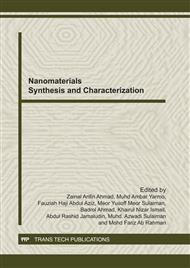p.485
p.489
p.494
p.500
p.504
p.510
p.515
p.519
p.524
The Effect of CeO2 and Fe2O3 Dopants on Ni/ Alumina Based Catalyst for Dry Reforming of Methane to Hydrogen
Abstract:
Methane reforming is the most feasible techniques to produce hydrogen for commercial usage. Hence, dry reforming is the environment friendly method that uses green house gases such as CO2 and methane to produce fuel gas. Catalysts play a vital role in methane conversion by enhancing the reforming process. In this study Ni/γ-Al2O3 was selected as based catalyst and CeO2 and Fe2O3 dopants were added to investigate their effect on catalytic activity in dry reforming. The catalysts synthesized through wet impregnation method and characterized by using XRD, TEM and SEM-EDX. The catalytic tests were carried out using temperature programmed reaction (TPRn) and the products were detected by using an online mass spectrometer. The results revealed that these dopants significantly affect the catalytic activity and selectivity of the catalyst during reaction. Hence, Fe2O3 doped catalyst shows higher hydrogen production with stable catalytic activity.
Info:
Periodical:
Pages:
519-523
Citation:
Online since:
October 2011
Authors:
Keywords:
Price:
Сopyright:
© 2012 Trans Tech Publications Ltd. All Rights Reserved
Share:
Citation:


